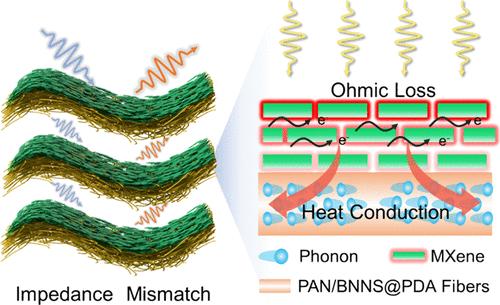在复合电磁干扰屏蔽膜中建立热传导纳米通道用于电磁热管理
IF 8.2
2区 材料科学
Q1 MATERIALS SCIENCE, MULTIDISCIPLINARY
引用次数: 0
摘要
在 6G 时代,小型化和高度集成的可穿戴通信设备需要具有高效热管理能力的电磁材料,以缓解电磁干扰(EMI)和热积累。在此,我们提出了一种通过在逐层 EMI 屏蔽膜内构建定向热传导纳米通道来传导电磁热的简便策略。这种复合薄膜由聚丙烯腈/氮化硼纳米片@聚多巴胺纳米纤维和基于 MXene 片的 EMI 层组成。与热量随机散失的传统材料相比,一维纤维结构可提供定向散热途径。在高功率微波辐照下,它的温度会明显降低,从而确保通信性能稳定持久,不会过热。这种薄膜(厚度为 0.43 毫米)在 18-24 GHz 频率下的比表面屏蔽效率达到了惊人的 29,400 dB-cm2-g-1,而逐层结构的 EMI 屏蔽效果(SE)为 88 dB。此外,柔性薄膜在弯曲 10,000 次后仍能保持较高的 EMI SE。其轻质、柔韧和薄型设计使其适用于各种环境中的坚固应用。这种 EMI 屏蔽和导热薄膜为可穿戴通信系统提供了快速散热和有效的信号屏蔽,展示了下一代通信技术中高效热管理的巨大潜力。本文章由计算机程序翻译,如有差异,请以英文原文为准。

Building Thermal-Conduction Nanochannels in Composite Electromagnetic Interference Shielding Film for Electromagnetic Heat Management
In the 6G era, miniaturized and highly integrated wearable communications devices require electromagnetic materials with efficient thermal-management capability to mitigate electromagnetic interference (EMI) and heat accumulation. Herein, we present a facile strategy for conducting electromagnetic heat by constructing directional thermal-conduction nanochannels within a layer-by-layer EMI shielding film. This composite film consists of polyacrylonitrile/boron nitride nanosheets@polydopamine nanofibers covered with an EMI layer based on MXene sheets. Compared with traditional materials in which the heat dissipates randomly, the one-dimensional fibrous structure can offer a directional heat dissipation pathway. Under high-power microwave irradiation, it exhibits significantly lower temperatures, ensuring robust and durable communication performance without overheating. The thin film (0.43 mm thickness) achieves an impressive specific surface shielding efficiency of 29,400 dB·cm2·g–1 at 18–24 GHz, with an EMI shielding effectiveness (SE) of 88 dB for its layer-by-layer structure counterpart. In addition, the flexible film maintains a high EMI SE after 10,000 bending times. Its lightweight, flexible, and thin design makes it suitable for robust applications in various environments. This EMI shielding and thermally conductive film provides rapid heat dissipation and effective signal shielding for wearable communication systems, showcasing the great potential for efficient thermal management in next-generation communication technologies.
求助全文
通过发布文献求助,成功后即可免费获取论文全文。
去求助
来源期刊

ACS Applied Materials & Interfaces
工程技术-材料科学:综合
CiteScore
16.00
自引率
6.30%
发文量
4978
审稿时长
1.8 months
期刊介绍:
ACS Applied Materials & Interfaces is a leading interdisciplinary journal that brings together chemists, engineers, physicists, and biologists to explore the development and utilization of newly-discovered materials and interfacial processes for specific applications. Our journal has experienced remarkable growth since its establishment in 2009, both in terms of the number of articles published and the impact of the research showcased. We are proud to foster a truly global community, with the majority of published articles originating from outside the United States, reflecting the rapid growth of applied research worldwide.
 求助内容:
求助内容: 应助结果提醒方式:
应助结果提醒方式:


